Periodic Solution of Prey-Predator Model with Beddington-DeAngelis Functional Response and Impulsive State Feedback Control
Abstract
A prey-predator model with Beddington-DeAngelis functional response and impulsive state feedback control is investigated. We obtain the sufficient conditions of the global asymptotical stability of the system without impulsive effects. By using the geometry theory of semicontinuous dynamic system and the method of successor function, we obtain the system with impulsive effects that has an order one periodic solution, and sufficient conditions for existence and stability of order one periodic solution are also obtained. Finally, numerical simulations are performed to illustrate our main results.
1. Introduction
The study of the dynamics of prey-predator system is one of the dominant subjects in both ecology and mathematical ecology due to the fact that predator-prey interaction is the fundamental structure in population dynamics. Many scholars have carried out the study of prey-predator system with various functional responses, such as Monod-type and Holling-type. It is well known that Beddington-DeAngelis functional response which was introduced by Beddington and DeAngelis et al. [1, 2] can avoid some of the singular behavior of ratio-dependent models at low densities and provide better description of predator feeding over a range of prey-predator abundances. Therefore, in this paper, we investigate prey-predator system with Beddington-DeAngelis functional response.
Impulsive differential equations have been widely used in various fields of applied sciences, for example, physics, ecology, and pest control. The majority of them just concern the system with impulses at fixed times [3–7]. However, in practical ecological system, the control measures (by poisoning or releasing the natural nenmy, etc.) are taken only when the amount of species reaches a threshold value, rather than the usual impulsive fixed-time control strategy. Impulsive state feedback equation is a powerful tool to manage these problems. Therefore, some researchers proposed the impulsive state feedback control models for population management [8–11].
In this paper, we mainly discuss the existence and stability of periodic solution of system (1.3) by using the geometry theory of semicontinuous dynamic system and the method of successor function which were introduced in the paper [15, 16], as far as we know, there are few papers to apply these methods to prove the existence of order one periodic solution, which makes the study simpler and clearer. What is worth saying is that modeling thoughts and mathematical methods used in this paper are of more important theoretical and practical value.
An outline of this paper is as follows: some definitions and theorems are given for the later use in the next section. The qualitative analysis of the system without impulsive effects is given in Section 3. In Section 4, the existence and stability of order one periodic solution of system (1.3) are investigated. Numerical simulations and some discussions are provided in Section 5.
2. Definitions and Lemmas
Definition 2.1 (see [15].)Differential equation with impulsive state feedback control
In this paper, R+ = [0, +∞), . , , , then system (1.3) constitutes a semicontinuous dynamical system (Ω, f, φ, M).
For any P ∈ Ω, the function fP : R+ → Ω defined as fP(t) = f(P, t) is continuous and we call fP(t) the trajectory passing through point P. The set C+(P) = {f(P, t)∣0 ≤ t < +∞} is called positive semitrajectory of point P. The set C−(P) = {f(P, t)∣ − ∞ < t ≤ 0} is called the negative semitrajectory of point P. For the convenience, if P ∈ Ω, F(P) is defined as the first intersection point of C+(P) and M, that is, there exists a t1 ∈ R+ such that F(P) = f(P, t1) ∈ M, and for 0 < t < t1, f(P, t) ∉ M.
Definition 2.2 (see [15].)A trajectory f(P, t) is called order one periodic solution with period T if there exists a point P ∈ N and T > 0 such that f(P, T) = Q ∈ M and φ(Q) = φ(f(P, T)) = P ∈ N.
Next we will give the definition of the successor function of semicontinuous dynamical system (1.3). First, we define a new number axis in set N. On straight line x = (1 − p)h, take the origin at point ((1 − p)h, 0) of coordinate axis x and define positive direction and unit length to be consistent with coordinate axis y, then we obtain a number axis l. For any x ∈ l, let l(x) be coordinate of point x.
Definition 2.3. Suppose g : N → N be a map. For any x ∈ N, there exists a t1 > 0 such that F(x) = f(x, t1) = x1 ∈ M, , then is called the successor function of point x, and the point is called the successor point of x.
Remark 2.4. If g(x0) = 0, the trajectory f(x0, t) with initial point x0 is an order one periodic solution of system (1.3).
According to the continuity of compound function, we know the following.
Lemma 2.5. The successor function g(x) is continuous.
In system (1.3), the isocline dx/dt = 0 is denoted by Γ1, the isocline dy/dt = 0 is denoted by Γ2. Let A((1 − p)h, yA) be the intersection point of isocline Γ1 and set N. If there exist two points x1 ∈ N, x2 ∈ N, which are both below A or above A, satisfying g(x1)g(x2) < 0, by the zero point theorem of continuous function in the closed interval, we know there exists a point x0 ∈ N which is between x1 and x2 such that g(x0) = 0, so we have the following.
Lemma 2.6 (existence theorem of order one periodic solution). The system (1.3) exists an order one periodic solution if there exist two points x1 ∈ N, x2 ∈ N, which are both below A or above A, satisfying g(x1)g(x2) < 0.
3. Qualitative Analysis of System (1.3) without Impulsive Effects
Lemma 3.1. The system (3.1) is uniformly bounded.
Proof. Let the straight line l1 = x − x1 = 0, we have , then the trajectory of system (3.1) from the right of l1 through the l1 into the left. Define a function V(x, y) = −(e/a2)x + fy − K, where 0 < x < x1. The function V(x, y) intersects the line x = x1 and axis y at the points H and G, respectively. We have . we can choose K enough large such that dV/dt|HG < 0. Hence, the system (3.1) is uniformly bounded (see Figure 1). The proof is completed.
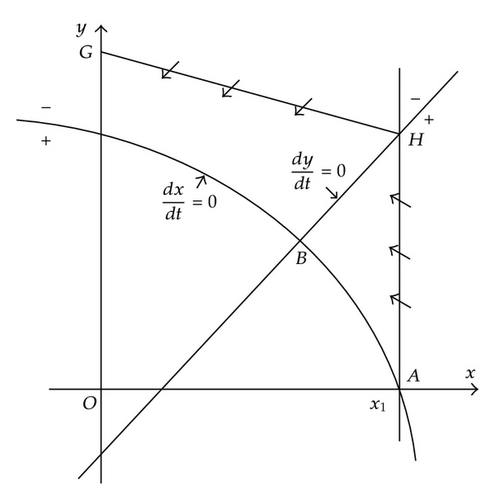
In the following, we will analysis the stability of equilibrium and B(S*, x*) of system (3.1). Clearly, O(0,0) is saddle point and if a3 > 1 + a1, is stable, otherwise is saddle point and the positive equilibrium point B(S*, x*) exists. For the positive equilibrium point, we have the following result.
Theorem 3.2. The positive equilibrium point B(S*, x*) is globally asymptotically stable if a3 < 1 + a1.
Proof. The Jacobian matrix JB = J(x*, y*) of system (3.1) at B takes the form of
Let P(x, y) = fx(1 + a1x + a2y − a3x2 − a4xy), Q(x, y) = ey(x − y − 1) and B = xα−1yβ−1, where α = −a1/(1 + a1), β = αf/e, then we have
4. Existence and Stability of Periodic Solutions of System (1.3)
4.1. Existence of Order One Periodic Solution
In this section, we will investigate the existence of order one periodic solution of system (1.3) by using the method of successor function. Note that system (1.3) is a semicontinuous dynamical system, for convenience, any point C, let xC denote its abscissa and yC be its ordinate. If C = (h, yC) ∈ M, then impulse occurs at point C, the impulsive function transfers the point C into C+. Without loss of generality, unless otherwise specified we assume the initial point of the trajectory lies in N. From discussion of Section 3, we know that B is globally asymptotically stable when a3 < 1 + a1. If h > x*, (1 − p)h > x*, all the solutions of system (1.3) tend to the equilibrium B after finite impulse, so we mainly pay attention to the case h < x* or h > x* and (1 − p)h < x*.
Case I (h < x*). In this case, sets M and N are both in the left side of point B. Trajectory passing through point A tangents to N at point A. Set F(A) = E(h, yE) ∈ M, then impulse occurs at point E. Suppose point E is subject to impulsive effects to point , here , the position of E+ has the following three cases.
Case I1 (). E+ coincides with A, and the successor function of A is , so trajectory and segment EA formulate an order one periodic solution of system (1.3).
Case I2 (). In this case, E+ is above A. Set F(E+) = E1 ∈ M, in view of vector field and disjointness of any two trajectories, we know , so we have , then the successor function of E+ is .
Take another point D((1 − p)h, yA + ε) above A, where ε > 0 is small enough. Set F(D) = D1 ∈ M, in view of continuous dependence of the solution on initial value and time, we know and the point D1 is close to E enough, so we have and the point is close to E+ enough, since , then we obtain . By Lemma 2.6, we know there exists an order one periodic solution of system (1.3), whose initial point is between D and E+ in set N (see Figure 2).
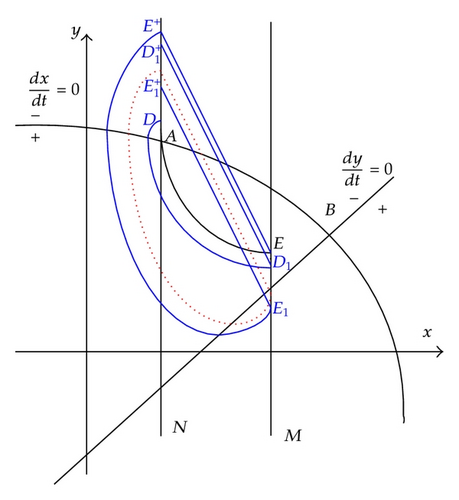
Case I3 (). In this case, E+ is below A. We have , so , then the successor function of E+ is .
Take another point A1((1 − p)h, ε) ∈ N satisfying 0 < ε < ι. Set F(A1) = E2 ∈ M, then , so we have . By Lemma 2.6, we know there exists an order one periodic solution of system (1.3), whose initial point is between E+ and A1 in set N (see Figure 3). Therefore, we have the following theorem.
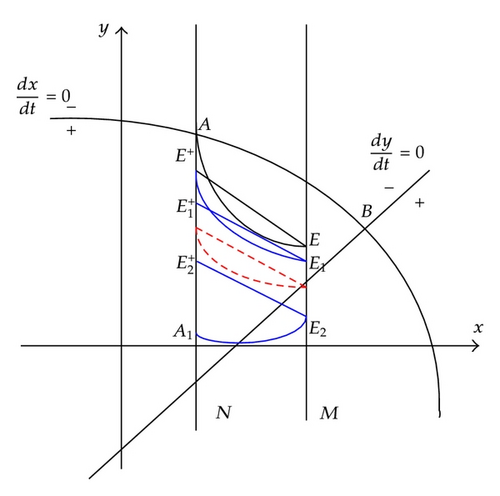
Theorem 4.1. Suppose that a3 < 1 + a1, h < x*, then system (1.3) has an order one periodic solution.
Case II (h > x*, (1 − p)h < x*). In this case, set M is in the right side of B and set N in the left of B. Denote the intersection point of isocline Γ1(dx/dt = 0) and set M by A(h, yA). The trajectory passing through point A tangents to M at point A. G(xh, yh) is defined as the first intersection point of C−(A) and Γ1, that is, there exists a T1 > 0 such that f(A, −T1) = G ∈ C−(A)⋂ Γ1, and for −T1 < t ≤ 0, f(A, t)⋂ Γ1 = ∅.
Case II1 (xG < (1 − p)h). There exist T2, T3 > 0 such that C ∈ C−(A)⋂ N, D ∈ C−(A)⋂ N, f(A, −T2) = D, f(A, −T3) = C, and for −T3 < t < −T2, f(A, t)⋂ N = ∅. Suppose point A is subject to impulsive effects to point .
If A+ coincides with C or D, trajectory and segment DA or trajectory and segment AC formulate an order one periodic solution of system (1.3).
If A+ is below D, that is, , the successor function of D is . Take another point D1((1 − p)h, ε) ∈ N satisfying 0 < ε < ι. Set F(D1) = D2 ∈ M, then , then we have . We conclude that there exists an order one periodic solution of system (1.3), whose initial point is between D and D1 in set N (see Figure 4).
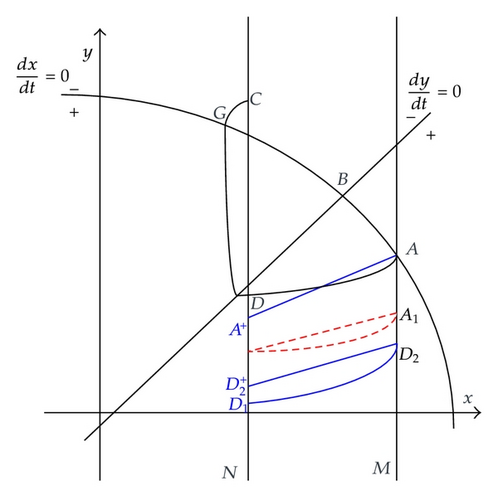
If A+ is above C, that is, , the successor function of C is . Set F(A+) = A1 ∈ M, in view of the vector fields of system (1.3), we know , so we have . We conclude that there exists an order one periodic solution of system (1.3), whose initial point is between C and A+ in set N (see Figure 5).
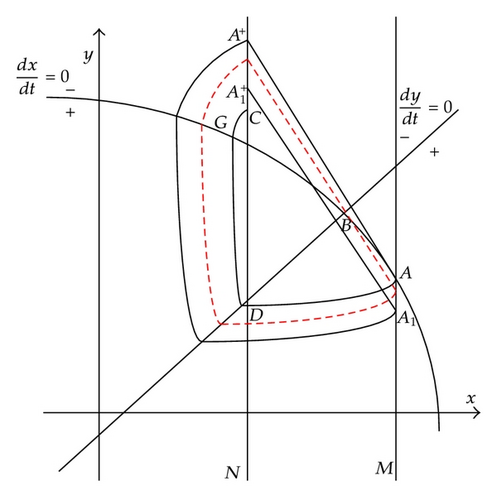
If A+ is between C and D, in view of vector fields, we know the trajectory of system (1.3) initiating any point between C and D of set N will be free from impulsive effects and ultimately tend to stable point B, thus there does not exist order one periodic solution in system (1.3) in this case. So we have the following.
Theorem 4.2. Suppose that a3 < 1 + a1, h > x*, (1 − p)h < x* and xG < (1 − p)h, or , then system (1.3) has an order one periodic solution.
Case II2 (xG > (1 − p)h). Denote the intersection point of isocline Γ1 and set N by K((1 − p)h, yK). The trajectory passing through point K tangents to N at point K. Set F(K) = S(h, yS) ∈ M, then impulse occurs at point S. Suppose point S is subject to impulsive effects to point . Like the analysis of Case I, we can prove that there exists an order one periodic solution in system (1.3) in this case (see Figure 6).
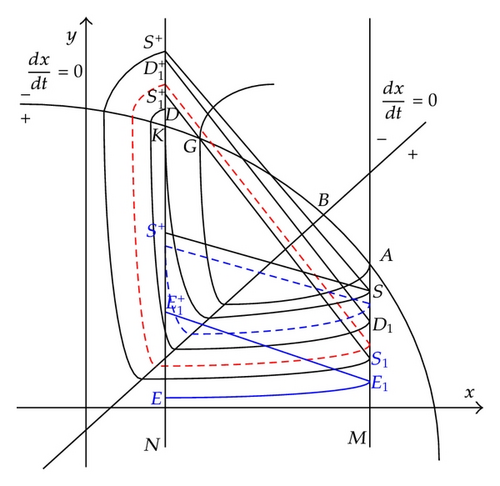
Theorem 4.3. Suppose that a3 < 1 + a1, h > x*, (1 − p)h < x* and xG > (1 − p)h, then system (1.3) exists an order one periodic solution.
In the following, we analyze the stability of order one periodic solution in system (1.3). Firstly, we give one lemma to discuss the stability of this periodic solution of system (1.3).
Lemma 4.4. The T-periodic solution x = ξ(t), y = η(t) of the system,
The proof of this lemma is referred to Simeonov and Baĭnov [17].
Theorem 4.5. If system (1.3) has an order one periodic solution, this order one periodic solution is orbitally asymptotically stable provided
5. Numerical Analysis and Discussion
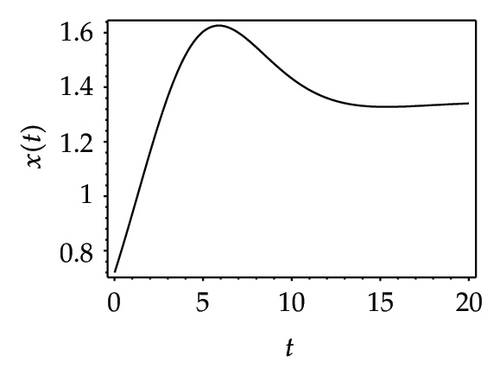
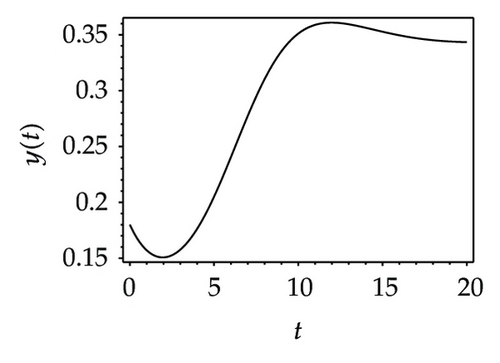
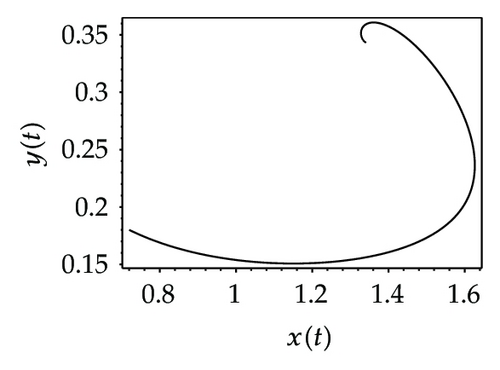
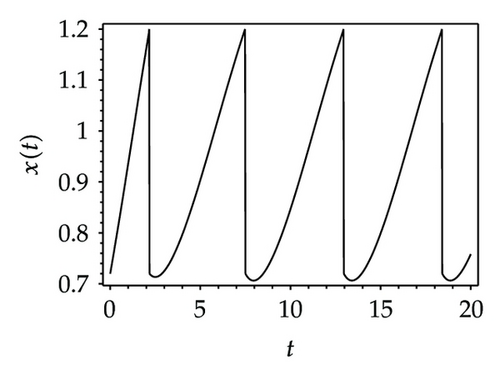
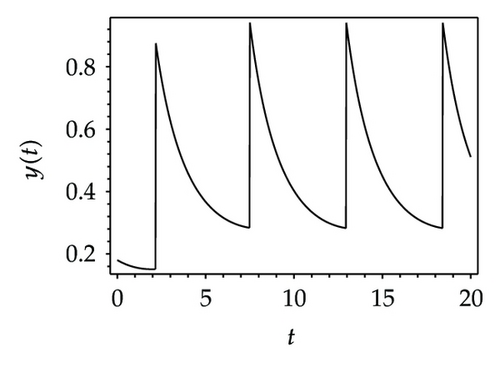
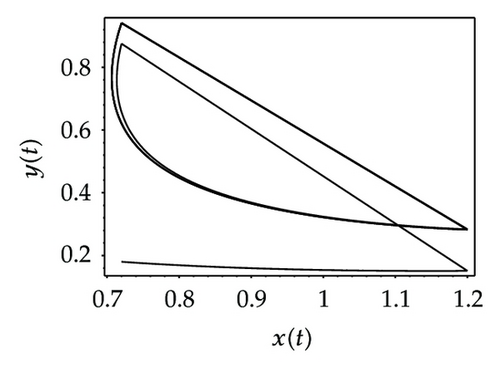
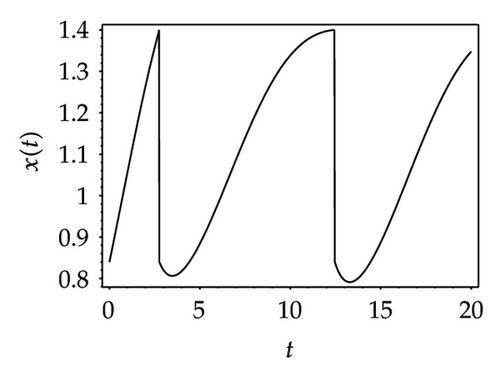
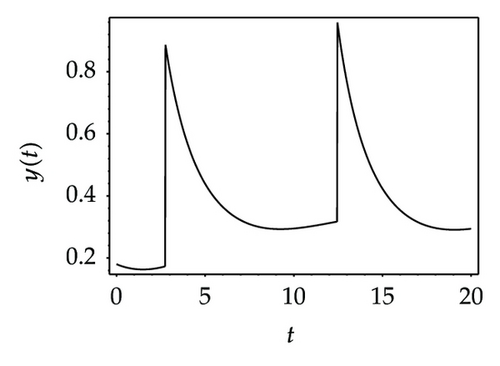
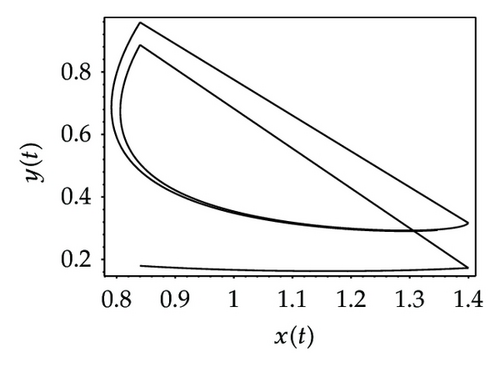
Choosing ι as a control parameter, the phase portraits of system (1.3) are shown in Figure 10 with different values ι, which not only indicate that the prey can be suppressed below certain level by using the impulsive state feedback strategy when the amount of the prey reaches the economic threshold h, but also indicate that it is more easy to control the amount of the prey below certain economic threshold h as ι increasing. On the other hand, if choosing h as a control parameter, we can see that more numbers of impulses are needed to make the system tend to a stable periodic solution, that is, it is more difficult to control the amount of the prey below economic threshold h as h is decreasing (see Figure 11). Figure 12 shows that it is more easy to control the amount of the prey under certain economic threshold h as q is increasing or p is increasing (see Figure 13).
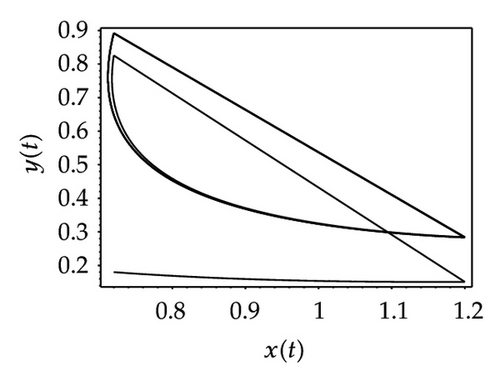
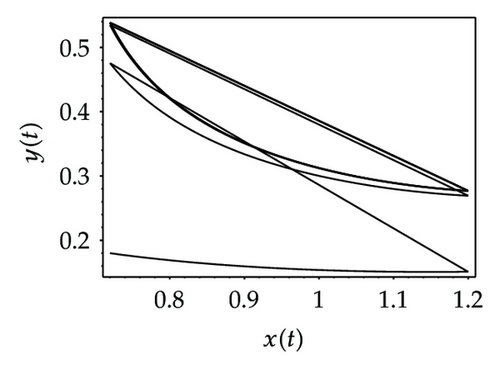
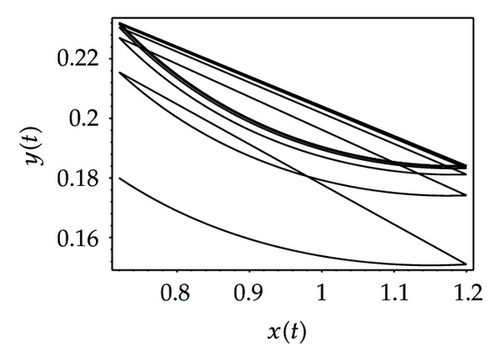
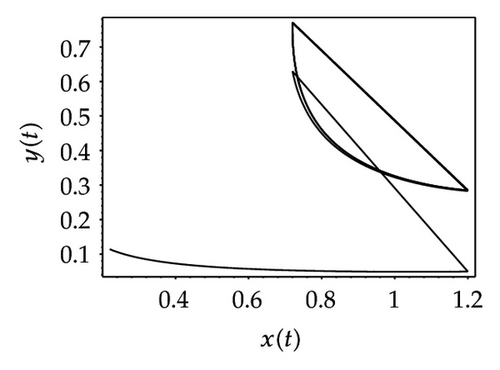
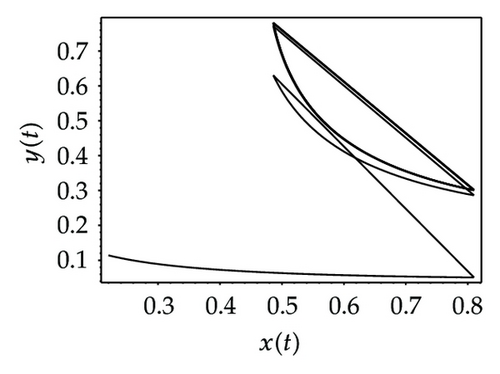
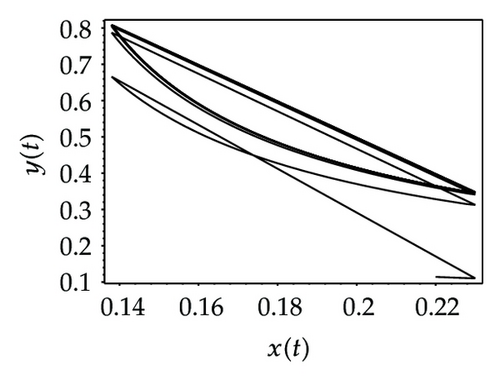
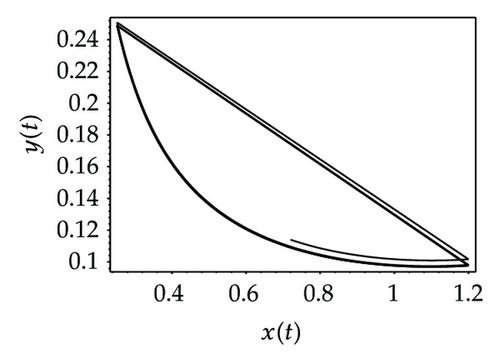
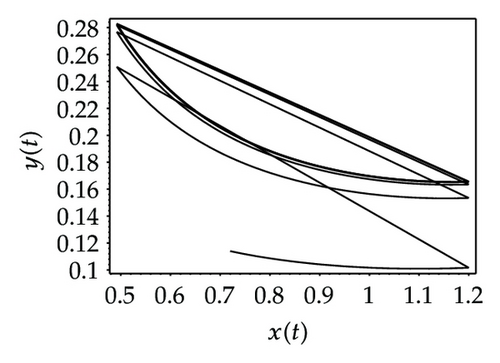
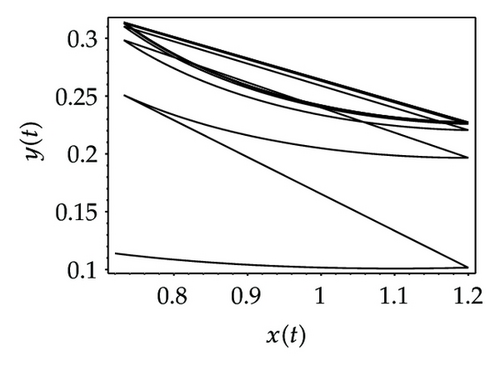
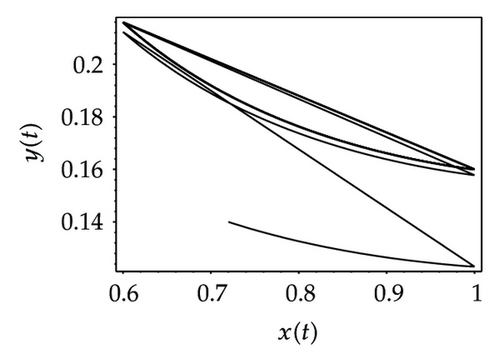
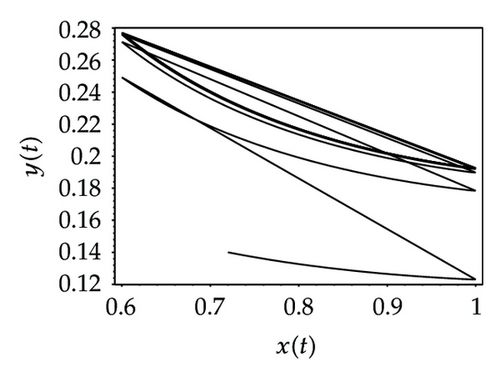
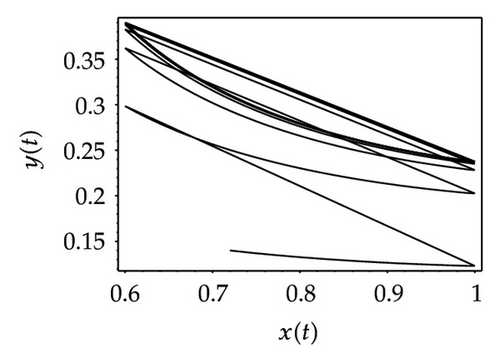
According to the above analysis, it is obvious that the prey can be well suppressed below certain level by using impulsive state feedback strategy for the fact that the system has stable periodic solution under some conditions. The key to the system with impulsive state feedback control is to give the suitable feedback state (the value of h) and the control parameters (p, q and ι) according to practice.
Acknowledgments
This work is supported by the National Natural Science Foundation of China (11171284), the Fujian Provincial Natural Science Foundation of China (2012J01012), the Fujian Provincial Education Fundation (JA12198), and the Scientific Research Foundation of Jimei University of China (ZC2011003).




